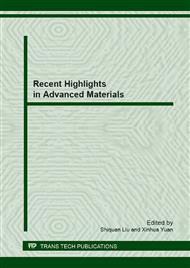[1]
Japan Concrete Institute, in: Tazawa (Ed. ), Technical Committee Report on Autogenous Shrinkage, Proc. of Int. Workshop, E&FN Spon, London, 1998, 1-63.
Google Scholar
[2]
Wiegrink K, Marikunte S, Shah SP. Shrinkage cracking of high strength concrete. ACI Mater J 1996; 93(5): 409–15.
Google Scholar
[3]
Grzybowski M, Shah SP. Shrinkage cracking of fiber reinforced concrete. ACI Mater J 1990; 87(2): 138–48.
Google Scholar
[4]
Weiss WJ, Shah SP. Restrained shrinkage cracking: the role of shrinkage reducing admixtures and specimen geometry. Mater Struct 2002; 35: 85–91.
DOI: 10.1617/13799
Google Scholar
[5]
G. Chengju, Maturity of concrete: method for predicting early-stage strength, ACI Mater. J. 86 (4) (1989) 341-353.
Google Scholar
[6]
Turcry P, Loukili A, Barcelo L, Casabonne JM. Can the maturity concept be used to separate autogenous shrinkage and thermal deformation of a cement paste at early age? Cem Concr Res 2002; 32 (9): 1443-1450.
DOI: 10.1016/s0008-8846(02)00800-1
Google Scholar
[7]
Bjøntegaard Ø, Sellevold E. Effect of silica fume and temperature on autogenous deformation of high performance concrete. In: Jensen OM, Bentz DP, Lura P, editors. Autogenous deformation of concrete. ACI International SP. 220-9; 2004. p.125–40.
DOI: 10.14359/13154
Google Scholar
[8]
P. Freiesleben Hansen, E.J. Pedersen, Maturity computer for controlled curing and hardening of concrete, Nord. Betong 1 (1977): 21-25.
Google Scholar
[9]
American Society for Testing and Materials. Standard specification for chemical admixtures for concrete, ASTM C39/C39M-11a, Philadelphia.
Google Scholar
[10]
Igarashi S, Bentur A, Kovler K. Autogenous shrinkage and induced restraining stresses in high-strength concrete. Cement Concrete Res 2000; 30: 1701–1707.
DOI: 10.1016/s0008-8846(00)00399-9
Google Scholar
[11]
I. Chu, S. H. Kwon, M. N. Amin, J. K. Kim. Estimation of temperature effects on autogenous shrinkage of concrete by a new prediction model. Construction and Building Materials 2012, 35 (3): 171-182.
DOI: 10.1016/j.conbuildmat.2012.03.005
Google Scholar


